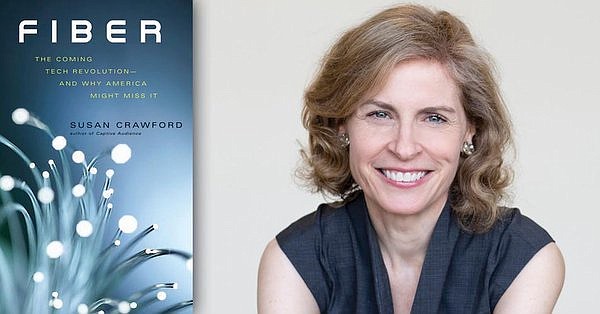"FIBER: THE COMING TECH REVOLUTION AND WHY AMERICA MIGHT MISS IT" (by Susan Crawford, 2018).
Harvard Law professor Susan Crawford invites us to play in the "fiber-optic innovation sandbox" in this book that offers insight into the current and potential future for this technology. She explains the very basic material properties and advantages of fiber-optic networks and then primarily focuses on the ramifications and possibilities of extensive fiber-optic adoption for any municipality.
Crawford lays out the history, highlighting great progress emerging internationally in contrast to the much slower (and at times regressive) approach here in the United States that hobbles this country in contrast to other emerging world powers.
If you go
› What: Susan Crawford presentation and book signing› When: 5-6:30 p.m. Thursday, April 25› Where: The Edney Innovation Center, floor 5, 1100 Market St.› Admission: Free
Her discussion brought me back to a long-forgotten paper I wrote as an engineering student for a Mechanics of Materials class on the bright future of fiber optics. After doing my research in the campus library before the internet was even a dream, I typed my paper out on a borrowed word processor because mainframes were reserved for use only by my computer programming classes. I wrote about the amazing work being done in the Middle East and presented a vision of fiber-optic materials that would revolutionize our world as we approached the end of the 20th century. Now, 30 years later, typing a review on Google docs about a book I read on my iPhone, it is amazing to realize how much technology has advanced but how little fiber-optic universality has been realized since my college days.
And that is, of course, Crawford's point as she delves into the highlights and lowlights of this history in select cities - the bootstrap determination of rural Winthrop Minnesota, the tech entrepreneur rich but incredibly digitally divided city of San Francisco and the quiet thunder of movements made by Whirligig Wilson North Carolina and the way that rippled into legislation that crippled the struggling Greensboro area on the other side of the state. And of course Chattanooga figures prominently as a city in which utilities bookend a century of innovation - from TVA's federally driven electrification of our region to today's EPB bringing our region into fiber optic dominance.
As she clearly proves, this transition is critical as it offers great potential not just for high-speed web access but also for energy conservation, educational equity, widespread personalized medical access and economic prosperity on the micro and macro level. With all of this potential, one might assume that offering affordable and universal fiber-optic access would be a no-brainer for any city. But with competing business interests, lobbyists and at times the duplicity of government over intervention and laissez faire waffling, many cities have been unable to take steps to realize these goals.
In this book, lobbyists and the cable monopolies hiring them are demonized and the government officials who allow these groups to control legislation are portrayed as irresponsible bureaucrats who are sacrificing the health and well-being of their communities. While many reading this book may already be among the converted, it is in many ways written as a call to these legislators and even more perhaps to their constituents whose wallets and votes can help make change.
Our own chatta-gig-city gets lots of props as the "Chattanooga Way" is heralded as a driver for our regional success thanks to EPB and city leadership's vision as well as the public-private partnership support for this process. She touts the way that this has allowed our city to attract companies and jobs and to better manage our power (in a city we all know is pounded by powerful storms and extreme weather that not long ago held us in a powerless standstill regularly). And she presents other ways we've been able to take this to the next generation - through the STEM school, through the certifications offered through TCAT and through Chattanooga 2.0's programs in historically underserved communities. The book is filled with interviews with many who lead up these efforts and the story, while familiar to most Chattanoogans, is likely aspirational for readers from other cities that struggle in this sandbox.
With all her praise though, she is careful not to sugarcoat the realities.
As she states, "Chattanooga is not the promised land." She is clear that we still have a lot of work to do here to reach true digital equity. She points out access price points, generational poverty, educational disparity, weak public transit and the dangerous health crisis and lack of access in our highest poverty areas as significant hurdles we still need to overcome to truly realize the potential of these cables laid throughout our community. In this, she gives us a blueprint and international models on which we can continue to build our gig city.
Adera Causey is curator of education at the Hunter Museum of American Art.
